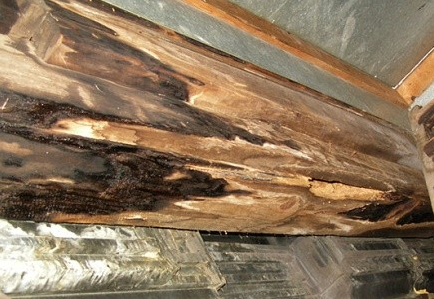Timber boasts quality in both strength and longevity, but untreated damp can be extremely destructive to timber and can result in extensive repair bills.
In this guide, we lay out some of the best ways to spot damp and protect your timber so you can enjoy a long-lasting structure for years to come.

Damp
There are many different ways in which damp can affect a property. Damp is caused by the build-up of excess water within a building, from either internal moisture or intrusion from outside. This dampness often relates to one of three main issues.
Rotten luck: One of the main consequences of damp that can be detrimental to your timber is rot. As discussed in a previous blog, both wet rot and dry rot thrive in damp conditions. Rot eats away at the wood, which results in a loss of weight and completely saps the strength out of it.
Rising damp: Rising damp occurs when water from the ground is able to ‘wick’ upwards through the bricks and mortar of a building – much like the way that oil rises up through the wick of a lamp. It can also be caused by left condensation, which we’ll go into in more detail below.
Penetrating damp: Poor external structures, such as cracked bricks or renders risk allowing water to penetrate the building (from bad weather or damaged guttering) resulting in penetrating damp. Signs of penetrating damp could be stained internal plaster, plaster falling off walls or peeling wallpaper.
Often, penetrating damp can easily be fixed and is usually just the case of identifying the source of the problem and leaving the affected area to dry-out naturally, without the need of any internal work to be carried out.
Condensation: Condensation is commonly caused by warm, moist air from household activities (like cooking or washing) condensing onto colder surfaces in the home – such as walls, windows and ceilings. Condensation comes from water vapour being created from within a building that has nowhere to escape. Buildings that have poorly insulated walls are prone to this problem.
The key signs of condensation is water collecting on the inside of windows or on the window sill. It can form on any surface but may not be noticed until black mould growth occurs. Other signs are decayed timer around window and door frames and water running down wall and pipes.
Not only does extreme cases of condensation affect the strength of timber, it can lead to a spread of bacteria throughout the home that can increase respiratory problems such as asthma.
Condensation remedies may include background heat, additional ventilation, air vents, use of fans and a reduction of moisture generation.

Removing and Protecting
The first step to take to protect your timber from damp is to identify the source of water – and eliminate it. Damp could be caused by a number of culprits, such as a leaky drain-pipe, condensation, a missing roof-tile or blocked air brick.
Once you’ve dealt with the culprit, you’ll need to thoroughly ventilate the area. The best way to do this is to use dehumidifiers, while keeping the heat on low – this will remove the moisture and ultimately reduce any chance of the damp continuing to spread or come back.
The ideal moisture content of all timber should be below 16 to 18 per cent. To do so, the timber needs to be segregated from other damp materials – either by air space or damp-proof membrane, allowing free air movement.
Anything else?
We hope we’ve provided you with some clear instructions on how to protect your timber fixtures from damp, but if you’d like share some of your own tips, or want to know more about any of the topics discussed above, then feel free to contact us via Twitter.
And be sure to check out our range of treated timbers that boast high damp resistance, or simply get in touch to find out more today.
